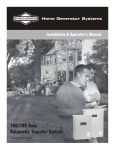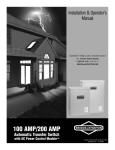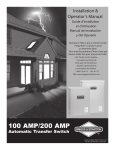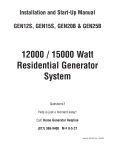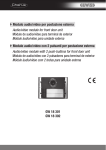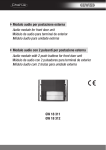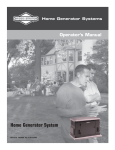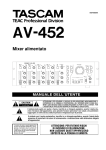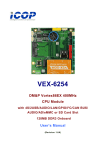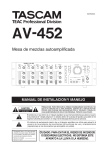Download Rheem GEN20B Operator`s manual
Transcript
Thank you for your purchase of this Rheem/Ruud . This product is intended for use with Rheem and Ruud Home Standby Generator sets ONLY. This is an optional home standby system which provides an alternate source of electric power and to serve loads such as a gas furnace, refrigeration and communication systems that, when stopped during any power outage, could cause discomfort, or the like. This manual contains safety information to make you aware of any hazards and risks associated with StatStation and how to avoid them. Rheem has made every effort to provide for a safe, streamlined and cost-effective installation. Each installation is unique, it is impossible to know of and advise of all conceivable procedures and methods by which installation might be achieved. We do not know all possible hazards and/or the results of each method or procedure. Save these instructions for future reference. This StatStation requires installation before use. Refer to the Installation section of this manual for instructions on installation procedures. Only licensed electrical contractors should install transfer switches. Installations must strictly comply with all applicable federal, state and local codes, standards and regulations. Where to Find Us You never have to look far to find support and service for your StatStation. Consult your Yellow Pages. There are many Rheem and Ruud authorized service dealers who provide quality service. You can also contact Rheem/Ruud Customer Service by phone at (877) 369-9400. StatStation Model Number Revision Serial Number Date Purchased Rheem Sales Company Randleman, NC 27317 (877) 369-9400 Copyright © 2007 Rheem Sales Company. All rights reserved. No part of this material may be reproduced or transmitted in any form by any means without the express written permission of Rheem Sales Company. Table of Contents Important Safety Instructions . . . . . . . . . . . . . . . . . . . . . . . . . . . . . . . . . 2 Equipment Description. . . . . . . . . . . . . . . . . . . . . . . . . . . . . . . . . . . . . . . . . 3 Installation . . . . . . . . . . . . . . . . . . . . . . . . . . . . . . . . . . . . . . . . . . . . . 4 Unpack StatStation . . . . . . . . . . . . . . . . . . . . . . . . . . . . . . . . . . . . . . . . . . . 4 Transmitter Mounting Guidelines. . . . . . . . . . . . . . . . . . . . . . . . . . . . . . . . . 4 Sensing Wire Interconnections . . . . . . . . . . . . . . . . . . . . . . . . . . . . . . . . . . 5 Display Console Installation. . . . . . . . . . . . . . . . . . . . . . . . . . . . . . . . . . . . . 6 Controls and Features . . . . . . . . . . . . . . . . . . . . . . . . . . . . . . . . . . . . . . 7 Operation . . . . . . . . . . . . . . . . . . . . . . . . . . . . . . . . . . . . . . . . . . . . . . 8 Setting Up Your StatStation. . . . . . . . . . . . . . . . . . . . . . . . . . . . . . . . . . . . . 8 Viewing the Maintenance Schedules and History . . . . . . . . . . . . . . . . . . . 10 Viewing Outage, Power Mode, and Exercise . . . . . . . . . . . . . . . . . . . . . . . 10 Maintenance . . . . . . . . . . . . . . . . . . . . . . . . . . . . . . . . . . . . . . . . . . . 11 StatStation Maintenance . . . . . . . . . . . . . . . . . . . . . . . . . . . . . . . . . . . . . . 11 Generator Maintenance . . . . . . . . . . . . . . . . . . . . . . . . . . . . . . . . . . . . . . . 11 Resetting StatStation after Generator Maintenance . . . . . . . . . . . . . . . . . . 11 Troubleshooting . . . . . . . . . . . . . . . . . . . . . . . . . . . . . . . . . . . . . . . . . 12 Illustrated Parts List. . . . . . . . . . . . . . . . . . . . . . . . . . . . . . . . . . . . . . . . . . 14 Warranty . . . . . . . . . . . . . . . . . . . . . . . . . . . . . . . . . . . . . . . . . . . . . . 15 Español Français 1 SAVE THESE INSTRUCTIONS Important Safety Instructions This is the safety alert symbol. It is used to alert you to potential personal injury hazards. Obey all safety messages that follow this symbol to avoid possible injury or death. The safety alert symbol ( ) is used with a signal word (DANGER, CAUTION, WARNING), a pictorial and/or a safety message to alert you to hazards. DANGER indicates a hazard which, if not avoided, will result in death or serious injury. WARNING indicates a hazard which, if not avoided, could result in death or serious injury. CAUTION indicates a hazard which, if not avoided, might result in minor or moderate injury. NOTICE indicates a situation that could result in equipment damage. Follow safety messages to avoid or reduce the risk of injury or death. The manufacturer cannot possibly anticipate every possible circumstance that might involve a hazard. The warnings in this manual, and the tags and decals affixed to the system components are, therefore, not all-inclusive. If you use a procedure, work method or operating technique that the manufacturer does not specifically recommend, you must satisfy yourself that it is safe for you and others. You must also make sure that the procedure, work method or operating technique that you choose does not render the system unsafe. WARNING Only qualified electricians should attempt installation of this system, which must strictly comply with applicable codes, standards and regulations. WARNING Low voltage wire cannot be installed in same conduit as power voltage wiring. • Failure to follow above warning could cause personal injury, damage and / or malfunction of equipment. 2 WARNING Failure to observe proper grounding techniques can result in electrocution. • DO NOT touch bare wires or receptacles. • DO NOT install transmitter in home standby installations having worn, frayed, bare, or otherwise damaged wiring. • DO NOT handle electrical cords while standing in water, while barefoot, or while hands or feet are wet. • If you must work around a unit while it is operating, stand on an insulated dry surface to reduce shock hazard. • In case of an accident caused by electrical shock, immediately shut down the source of electrical power and contact local authorities. Avoid direct contact with the victim. WARNING Transmitter is connected to equipment that contains hazardous voltage that can cause personal injury or death. • Despite the safe design of the system, operating this equipment imprudently, neglecting its maintenance or being careless can cause possible injury or death. CAUTION Improper treatment of wireless StatStation components can damage them and shorten their life. • Use transmitter only for intended uses. • If you have questions about intended use, ask dealer or contact Briggs and Stratton Power Products. • Install and use wireless StatStation components only in a sheltered or indoors location having an ambient temperature range of -4 °F to 158 °F (-20 °C to 70 °C). • DO NOT expose transmitter to excessive moisture, dust, dirt, or corrosive vapors. • Remain alert at all times while working on this equipment. NEVER work on the equipment when you are physically or mentally fatigued. • If connected devices overheat, turn them off and turn off their circuit breaker / fuse. INTRODUCTION NOTICE These devices comply with Part 15 of the FCC Rules. Operation of the devices is subject to the following: (A) The devices may not cause harmful interference, and (B) The devices must accept any interference that may cause undesired operation. This equipment has been tested and found to comply with the limits for a Class B digital device, pursuant to Part 15 of the FCC Rules. These limits are designed to provide reasonable protection against harmful interference in a residential installation. This equipment generates, uses, and can radiate radio frequency energy. If the equipment is not installed and used in accordance with the instructions, the equipment may cause harmful interference to radio communications. There is no guarantee, however, that such interference will not occur in a particular installation. Interference to radio or television reception can be determined by turning the equipment off and on. Your Rheem / Ruud StatStation is supplied with this combined “Installation and Operator’s Manual”. This is an important document and should be retained by the owner after the installation has been completed. Every effort has been expended to make sure that the information in this manual is both accurate and current. However, the manufacturer reserves the right to change, alter or otherwise improve the system at any time without prior notice. Equipment Description This wireless StatStation is designed to report on the status of your home standby system and requires: • Rheem / Ruud Home Standby Generator with Intelligen package • Rheem / Ruud Transfer Switch. Your home standby system provides an alternate source of electric power to serve loads such as a gas furnace, a refrigerator, or a communications system that, when stopped during any power outage, could cause discomfort or damage. This wireless StatStation includes a transmitter which sends the status of your system, including maintenance requirements and alarms, to a convenient display console inside your home. Every effort has been made to provide for a safe, streamlined and cost-effective installation. Each installation is unique, and it is impossible to know of and advise of all conceivable procedures and methods by which installation might be achieved. We do not know all possible hazards or the results of each method or procedure. For these reasons, Only licensed electrical contractors should install the transmitter component of your StatStation. Installations must strictly comply with all applicable federal, state, and local codes, standards, and regulations. For the Home Owner To help you make informed choices and communicate effectively with your installation contractor(s), Read and understand the Owner Orientation Section of this manual BEFORE contracting or starting your Wireless StatStation transmitter installation. To arrange for proper installation, contact the store at which you purchased your Rheem / Ruud StatStation, your dealer, or your utility power provider. The StatStation System Warranty is VOID unless the system is installed by a licensed electrical professional. The illustrations depict typical circumstances and are meant to familiarize you with the installation options available with your wireless StatStation. Local codes, appearance, and distances are the factors that must be considered when negotiating with an installation professional. As the distance from the existing electrical service increases, compensation in wiring materials must be allowed for. This is necessary to comply with local codes and overcome electrical voltage drops. The factors mentioned above will have a direct effect on the overall price of your wireless StatStation installation. NOTE: Your installer must check local codes AND obtain permits before installing the system. NOTICE Power must be disconnected from display console and transmitter during the entire installation process or component failure will occur. Follow installation instructions! 3 Installation Installer Responsibilities Read this Installation section carefully and become familiar with Homeowner Responsibilities, Installer Responsibilities, and the figures BEFORE contracting or starting your StatStation installation. NOTICE Power must be disconnected from display console and transmitter during the entire installation process or component failure will occur. Follow installation instructions! Unpack StatStation Included in the carton is (See Figure 1): • Display Console • Wireless Transmitter • AC/DC Adapter • (2) Current transformers • Installation and Operator’s Manual (not shown) Figure 1: Carton contents • Read and observe the Important Safety Instructions in the Safety section. • Read and follow the instructions given in this manual. • Check federal, state, and local codes before commencing installation. • If you need more information about the wireless StatStation system, call (877) 364-9400, between 8:00 AM and 5:00 PM CT. Transmitter Mounting Guidelines The wireless StatStation transmitter is enclosed in a NEMA Type 4 enclosure suitable for indoor use. Guidelines for mounting the transmitter include: • Install the switch on a firm, sturdy supporting structure within 50 feet (15 meters) of the transfer switch and with the serial number decal clearly visible. • NEVER install the transmitter where any corrosive substance might drip onto the enclosure. • NEVER install the transmitter inside any grounded metal cabinet or enclosure such as the transfer switch enclosure. • NEVER install the transmitter within 10 feet (3 meters) of another transmitting device, such as a wireless telephone. • Protect the transmitter at all times against excessive temperature, moisture, dust, dirt, lint, construction grit and corrosive vapors. A typical installation of the wireless StatStation transmitter is shown in Figure 2. Main Breaker Panel Automatic Transfer Switch Wireless Transmitter Power Management Panel Items Not Supplied: • Seven (7) ‘AA’ alkaline (2200mAH) batteries • Connecting wires • Mounting hardware and miscellaneous fasteners, conduit, etc. Homeowner Responsibilities • Read and follow the instructions given in this manual. • Follow a regular schedule in caring for and using your wireless StatStation, as specified in this manual. Convenience Outlet Figure 2: Typical wireless Transmitter Mounting Location 4 Sensing Wire Interconnections WARNING CAUTION Improper installation can cause damage to the circuit boards and shorten their life. Installing circuit boards in live circuits will damage the board is not a warranty condition. ALWAYS disconnect ALL sources of power prior to installation. • Remove all power prior to installing this wireless StatStation equipment. Failure to do so could cause internal damage to the components when making electrical connections. • Turn generator to OFF position. • Turn off utility power to the home standby generator and transfer switch. All wiring must be the proper size, properly supported and protected by conduit, per code. Complete the following connections between the wireless StatStation components, the transfer switch, and the generator, as shown in Figure 3. Low voltage wire cannot be installed in same conduit as power voltage wiring. • Failure to follow above warning could cause personal injury, damage and / or malfunction of equipment. IMPORTANT: Observe the maximum signal wire distance limitation (50 feet or 15 meters) on wire runs described in steps 1 to 6 below. 1. Using installer supplied 18AWG stranded wire, connect transmitter’s ground terminal (J4, 7th terminal from left), to ‘GND’ terminal on transfer switch control board (J7, leftmost terminal). See Figure 3. 2. Using installer supplied 18AWG stranded wire, connect transmitter 8th terminal from left on J4 to ‘T’ terminal on transfer switch control board (J7, 2nd terminal from left). J7 Automatic Transfer Switch Wireless Transmitter J8 J4 Main Circuit Breaker Panel Neutral Bus Generator Enclosure Generator Control Panel TxRx terminals Ground Bus Figure 3: Transmitter Wiring Diagram 5 3. Using installer supplied 18AWG stranded wire, connect transmitter’s 9th terminal from left on J4 to ‘R’ terminal on transfer switch control board (J7, 3rd terminal from left). 4. Using installer supplied 18AWG stranded wire, connect transmitter’s rightmost J4 terminal to ‘+V’ terminal on transfer switch control board (J7, rightmost terminal). 5. Using installer supplied 18AWG stranded wire, run sufficient length of a pair of wires through conduit from transfer switch to generator. Connect ‘GND’ terminal on transfer switch control board (J8, left terminal) to wire harness attached to generator control panel at ‘TxRxGND’ position (5th terminal down from top) 6. Using second wire run in 5. above, connect ‘T/S’ terminal on transfer switch control board (J8, right terminal) to wire harness attached to generator control panel at ‘TxRx’ position (4th terminal down from top) 7. Install three (3) AA batteries in transmitter. Observe battery polarity. This completes the StatStation transmitter installation. 6 Extra Current Transformers were supplied in the event the home standby system has a Power Management System already installed. Review the Power Management System installation instructions to ensure all connections associated with that system have not been disturbed. Display Console Installation 1. Find an indoor location for the display console that is convenient for both viewing status reports and receiving audible alarms. The location must be within 200 ft (61 m) of the transmitter and have a nearby electrical receptacle. 2. Insert four (4) AA batteries into the back of the display console. 3. Attach the AC/DC adapter to the display console and plug it into the electrical receptacle. 4. Follow the instructions given under Setting Up Your StatStation in the Operation section. Controls and Features Read this operator’s manual and safety rules before operating your wireless StatStation. Compare the illustrations with your display console to familiarize yourself with the locations of various controls and features. Save this manual for future reference. A B G C H D I E H F A - Signal Strength — The number of bars to the right of the signal strength symbol indicate how strong the signal is between display console and transmitter. Zero bars indicate no signal, five bars maximum signal. B - Time — Current time of day is shown. C - Date — Today’s date. D - System Status — Indicates current status of the system, such as: System Ready, Utility Power Outage, Generator Power Mode, Exercise Mode, System Alert Mode. E - Alarm — Audible Alarm setting symbol (High, Low, or Off). F - Battery Indicator — Battery strength indicator. Five bars indicate full strength. G - LED — Two color LED. Green indicates normal operation. Red indicates system alert. H - Up/Down Navigation Button — A touch control used to scroll through displayed menu options. Each touch will move the on-screen cursor one place up or down. I - Select Button — A touch control used to select the highlighted menu option. J K J - TxRx Indicator — Green LED flashes when sending or receiving data. K - Batteries — Install three (3) AA batteries here. L - System Serial Number plate — Use this nine digit number to synchronize transmitter and display console communication. L 7 Operation Figure 4: Main Menu Touch any button to activate the StatStation’s display console when it is in Idle Mode Touch again to display the Main Menu (see Figure 4). Pressing one of the two Navigation buttons directs the cursor up or down so the next option will be highlighted. When the desired option is highlighted, touch the Select button. In some screens, the Navigation and Select buttons help you execute on-screen instructions. If the display console is left inactive for one minute, it will return to Idle Mode and the screen backlight will turn off. The Main Menu will display five options: History, Maintenance Schedule, System Settings, System Sync, and Return to Idle Screen. Setting Up Your StatStation 1. From the Main Menu, scroll until System Settings is highlighted and press the Select button. The System Settings menu is displayed (see Figure 5). Figure 5: System Settings Menu 8 2. Select Date & Time. Follow on-screen commands within Date Adjust to set the date and do the same in Time Adjust to set the time. Note that Navigation buttons are used to set correct numbers and the Select button will move cursor from one position to the next. When all positions on the screen are set, select Finish. The correct time and date will now be displayed on the left side of the display (see Figure 4). Selecting Return to Previous Menu will again display the System Settings menu. 3. Select Audible Alarm. Choose from High, Low, or Off. The chosen setting is demonstrated and the display returns to the Audible Alarm Menu. The chosen alarm will now be displayed on the left side of the display (see Figure 4). This Alarm will sound when there are certain System Alerts. Selecting Return to Previous Menu will again display the Systems Setting Menu. 4. Select Display Screen. From there, select Backlight Adjust and set to High, Low, or Off. The chosen setting is demonstrated and the display returns to the Backlight Adjust Menu. Selecting Return to Previous Menu will again show the Display Screen menu. 5. Select Contrast Adjust. Navigate to Higher or Lower. While Higher or Lower is highlighted, each press of the Select button will move the indicator one increment right or left. Navigate to Select to select the current setting. 6. Keep selecting Return to Previous Menu until the Main Menu appears. 7. Select System Sync and the System Sync Mode will display (see Figure 6). Figure 6: System Sync Mode 9 8. Enter the 9-digit Serial Number from the label on the transmitter (see Controls and Features for location), following the instructions on the screen. When the last digit is selected, choose to Synchronize. 9. Select Confirm. After approximately 20 seconds, the display console will report that the system is “Synchronized” and return to Idle Mode. Or it may display a “System Sync Unsuccessful” message and return to the System Sync Mode. Refer to Troubleshooting if this message appears. 2. Select Return, then Return to Previous Menu to reach the Main Menu. 3. Select History to view the system’s Total Run Time and the time remaining until the Next Exercise (see Figure 8). Viewing the Maintenance Schedules and History 1. From the Main Menu select Maintenance Schedule (see Figure 7), then select Overview. The display console will report the time remaining before the next change is required for Air Cleaner, Oil & Filter, and Spark Plug(s). Figure 8: History Screen Viewing Outage, Power Mode, and Exercise Figure 7: Maintenance Menu 10 When a utility outage occurs, “Utility Power Outage” will be reported on the display console’s system status readout instead of “System Ready”. After the standby generator starts, “Generator Power Mode” will be reported until utility power is again recognized and the generator first cools down, then shuts down. When the standby system is in the exercise mode, the display console will report that, along with a countdown in minutes of the exercise. Maintenance Generator Maintenance StatStation Maintenance If alkaline (2200mAH) batteries are used, display console will operate for up to 40 hours, if the AC/DC Converter is not used. The transmitter will operate for up to 60 hours after utility and generator power is lost. A System Alert will be reported if the transmitter’s batteries are low. The left side of the display will indicate if the display console’s batteries are low. Be sure to keep fresh batteries in the components so your StatStation will be ready for the next outage. Your StatStation will report the time remaining before certain maintenance tasks must be performed on your standby generator. See Viewing the Maintenance Schedules and History in the Operation section. If the time interval for scheduled maintenance has passed, the StatStation will report System Alerts for scheduled maintenance and the LED will flash red. An audible alarm will not accompany Maintenance Schedule System Alerts. The following table lists the events tracked by the system. System Alert Mode – Maintenance Schedule System Alert Display Check Air Cleaner. Fault Cause Scheduled maintenance check Fault Remedy Check/Replace air cleaner and reset StatStation. Replace air cleaner and reset StatStation. Replace Air Cleaner. Total running hours reached Check Engine Oil Fill Level. Scheduled maintenance check Check engine oil fill level and reset StatStation. Change Oil & Filter. Total running hours reached Check Spark Plugs. Scheduled maintenance check Replace oil and filter and reset StatStation. Check spark plugs and reset StatStation. Change Spark Plugs. Total running hours reached Replace spark plugs and reset StatStation. Resetting StatStation after Generator Maintenance Follow the maintenance instructions in the operator’s manual for your standby generator carefully. Then reset the intervals on your StatStation. 1. From the Main Menu, navigate to Maintenance Schedule and select. 2. Navigate to Service Reset and select. 3. Choose which service(s) you would like to put back to full interval (see Figure 9) and select. Figure 9: Service Reset 11 Troubleshooting The StatStation will report System Alerts for problems with your generator and standby system and the LED will flash red. An audible alarm will accompany Generator and Standby System Alerts. System Alert Mode – Generator Faults System Alert Display Low Battery Voltage Fault Cause 1. Generator battery is low. Fault Remedy 1. Recharge or replace generator battery. Low Oil Pressure 1. Engine oil level is low. 2. Engine oil leaks. 1. Generator circuit breaker open. 2. Fault in generator. 3. Fault in connection. 4. Insufficient fuel supply. 1. Add oil to full mark on dipstick. 2. Contact authorized service center. 1. Close generator circuit breaker. 2. Contact authorized service center. 3. Contact authorized service center. 4. Check fuel delivery system. Contact authorized service center. 5. Clogged air filter. 1. Insufficient fuel supply. 5. Clean or replace air filter. 1. Check fuel delivery system. Contact authorized service center. 2. Faulty spark plugs. 3. Clogged air filter. 4. Faulty engine ignition. 1. Fault in generator. 2. Fault in connection. 3. Insufficient fuel supply. 2. Check spark plug. 3. Clean or replace air filter. 4. Contact authorized service center. 1. Contact authorized service center. 2. Contact authorized service center. 3. Check fuel delivery system. Contact authorized service center. 4. Clogged air filter. 1. Failed engine governor. 1. Generator access doors removed while running. 4. Clean or replace air filter. 1. Contact authorized service center. 1. Install generator access doors. 2. Obstructed cooling air inlet screens. 2. Check and clean generator cooling air inlet or exhaust port. 3. Clogged engine cooling fins. 4. Faulty temperature switch/wiring. 3. Contact authorized service center. 4. Contact authorized service center. Low Voltage Engine Fails to Start Low Frequency Engine Overspeed High Oil Temperature 12 System Alert Mode – Standby System Faults System Alert Display Switch G Coil Fail Switch U Coil Fail Generator Start Switch in OFF Position Fuse Fail One Wire Communication Fail Transmitter Battery Low Fault Cause 1. Transfer switch generator coil failure. 1. Transfer switch utility coil failure. 1. Generator start switch in OFF position. Fault Remedy 1. Contact authorized service center. 1. Contact authorized service center. 1. Set generator switch to AUTO position. 2. StatStation display too far away from transmitter. 2. Locate display within 200 ft (60 m) of transmitter. 3. Transmitter located in an area that interferes with the transmitter RF signal. 3. Locate transmitter in a location free of RF interference. 4. Transmitter, generator, or transfer switch signal wiring fault. 4. Contact authorized service center. 1. 2 Amp fuse in transfer switch failed. 1. Check/replace fuse. 2. Wiring failure. 2. Contact authorized service center. 1. Signal wire failure between generator, 1. Contact authorized service center. transfer switch, and transmitter. 1. Transmitter batteries low. 1. Replace transmitter batteries. StatStation System Fault System Sync Unsuccessful 1. Batteries exhausted. 2. Display console too far from transmitter or other signal interference. 1. Replace with fresh AA batteries. 2. Move console closer to transmitter. Replace transmitter AA batteries. 13 Illustrated Parts List 1 2 3 4 Item 1 2 3 4 Part # 197138GS 202756GS 195728GS 201092GS Items Not Illustrated 202766GS 14 Description ASSY, Transmitter ASSY, Display Console TRANSFORMER, Current ADAPTER, AC/DC MANUAL, Installation & Operator’s Warranty BRIGGS & STRATTON POWER PRODUCTS GROUP, LLC ACCESSORY WARRANTY POLICY Effective July 1, 2006 replaces all undated Warranties and all Warranties dated before July 1, 2006 LIMITED WARRANTY Briggs & Stratton Power Products Group, LLC will repair or replace, free of charge, any part(s) of the accessory that is defective in material or workmanship or both. Transportation charges on product submitted for repair or replacement under this warranty must be borne by purchaser. This warranty is effective for the time periods and subject to the conditions stated below. For warranty service, find the nearest Authorized Service Dealer in our dealer locator map at BRIGGSandSTRATTON.com. THERE IS NO OTHER EXPRESS WARRANTY. IMPLIED WARRANTIES, INCLUDING THOSE OF MERCHANTABILITY AND FITNESS FOR A PARTICULAR PURPOSE, ARE LIMITED TO NINETY DAYS FROM PURCHASE, OR TO THE EXTENT PERMITTED BY LAW. ANY IMPLIED WARRANTIES ARE EXCLUDED. LIABILITY FOR INCIDENTAL OR CONSEQUENTIAL DAMAGES ARE EXCLUDED TO THE EXTENT EXCLUSION IS PERMITTED BY LAW. Some states or countries do not allow limitations on how long an implied warranty lasts, and some states or countries do not allow the exclusion or limitation of incidental or consequential damages, so the above limitation and exclusion may not apply to you. This warranty gives you specific legal rights and you may also have other rights which vary from state to state or country to country. WARRANTY PERIOD Consumer Use 90 days Commercial Use 90 days The warranty period begins on the date of purchase by the first retail consumer or commercial end user, and continues for the period of time stated above. “Consumer use" means personal residential household use by a retail consumer. “Commercial use" means all other uses, including use for commercial, income producing or rental purposes. Once the product has experienced commercial use, it shall thereafter be considered as commercial use for purposes of this warranty. NO WARRANTY REGISTRATION IS NECESSARY TO OBTAIN WARRANTY ON BRIGGS & STRATTON PRODUCTS. SAVE YOUR PROOF OF PURCHASE RECEIPT. IF YOU DO NOT PROVIDE PROOF OF THE INITIAL PURCHASE DATE AT THE TIME WARRANTY SERVICE IS REQUESTED, THE MANUFACTURING DATE OF THE PRODUCT WILL BE USED TO DETERMINE THE WARRANTY PERIOD. ABOUT YOUR WARRANTY We welcome warranty repair and apologize to you for being inconvenienced. Any Authorized Service Dealer may perform warranty repairs. Most warranty repairs are handled routinely, but sometimes requests for warranty service may not be appropriate. For example, warranty service would not apply if equipment damage occurred because of misuse, lack of routine maintenance, shipping, handling, warehousing or improper installation. Similarly, the warranty is void if the manufacturing date or the serial number on the accessory has been removed or the equipment has been altered or modified. During the warranty period, the Authorized Service Dealer, at its option, will repair or replace any part that, upon examination, is found to be defective under normal use and service. This warranty will not cover the following repairs and equipment: • Normal Wear: Outdoor Power Equipment, like all mechanical devices, needs periodic parts and service to perform well. This warranty does not cover normal maintenance such as adjustments and cleaning. • Installation and Maintenance: This warranty does not apply to equipment or parts that have been subjected to improper or unauthorized installation or alteration and modification, misuse, negligence, accident, overloading, improper maintenance, repair or storage so as, in our judgment, to adversely affect its performance and reliability. • Other Exclusions: This warranty excludes wear items such as connectors, seals, batteries, or damage or malfunctions resulting from accidents, abuse, modifications, alterations, or improper servicing or freezing or chemical deterioration. This warranty excludes used, reconditioned, and demonstration equipment and failures due to acts of God and other force majeure events beyond the manufacturers control. 198208E, Rev A, 12/14/2006 BRIGGS & STRATTON POWER PRODUCTS GROUP, LLC JEFFERSON, WI, USA 15 Reserved



















